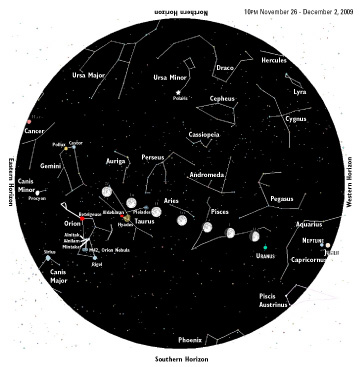Chesapeake Bay's Independent Newspaper ~ Since 1993
1629 Forest Drive, Annapolis, MD 21403 ~ 410-626-9888
Volume XVII, Issue 48 ~ November 26 - December 2, 2009
Home \\ Correspondence \\ from the Editor \\ Submit a Letter \\ Classifieds \\ Contact Us
Dining Guide \\ Home & Garden Guide \\ Archives \\ Distribution Locations \\ Advertising
![]()



Sky Watch

by J. Alex Knoll
The Season’s Celestial Feast
You’ll never fill up on these treats
While you’re walking off some of that Thanksgiving cheer, these long cool nights offer a feast that will never leave you full and bloated. The rising winter constellations provide some of the brightest stars and some of the most familiar shapes.
Taurus the bull leads the charge, cresting the east horizon as the sun sets in the west, around 4:45 this week. The bull’s glaring red eye is the star Aldebaran, surrounded by the Hyades star cluster, which makes up the bull’s head. Arabic for the follower, Aldebaran trails the seven sisters of the Pleiades cluster, less than 10 degrees east of Monday’s near-full moon.
Orion the hunter pursues the celestial bull. Its familiar hourglass shape and its many bright stars make Orion one of the easiest constellations to identify. The red-giant marking Orion’s shoulder is Betelgeuse, the seventh-brightest star, and blue-white Rigel, 11th-brightest, marks the hunter’s forward-planted foot. Perhaps more prominent are the dimmer stars of Orion’s belt, Alnitak, Alnilam and Mintaka, which form a straight line. Orion’s sword dangles from his belt, ending in what looks to the unaided eye like a fuzzy star but is in fact M42, the Great Orion Nebula.
At the hunter’s heels, low in the southeast, is his great hound Sirius. The Dog Star of Canis Major is the brightest celestial light in all the heavens. But if you look too early and to the east, the Little Dog Procyon, the eighth-brightest star whose name means before the dog, may fool you.
Higher above Canis Minor are the twins of Gemini, Castor and Pollux. As different as the mortal and human brothers of mythology, first-magnitude Pollux is the brighter of the two and glows a golden orange, while second-magnitude Castor twinkles white.
Illustration: © Copyright 1925 M.C. Escher/Cordon Art-Baarn-Holland; Graphics: © Copyright 2009 Pacific Publishers. Reprinted by permission from the Tidelog graphic almanac. Bound copies of the annual Tidelog for Chesapeake Bay are $14.95 ppd. from Pacific Publishers, Box 480, Bolinas, CA 94924. Phone 415-868-2909. Weather affects tides. This information is believed to be reliable but no guarantee of accuracy is made by Bay Weekly or Pacific Publishers. The actual layout of Tidelog differs from that used in Bay Weekly. Tidelog graphics are repositioned to reflect Bay Weekly’s distribution cycle.Tides are based on National Oceanic and Atmospheric Administration and are positioned to coincide with high and low tides of Tidelog.
© COPYRIGHT 2009 by New Bay Enterprises, Inc. All rights reserved.
